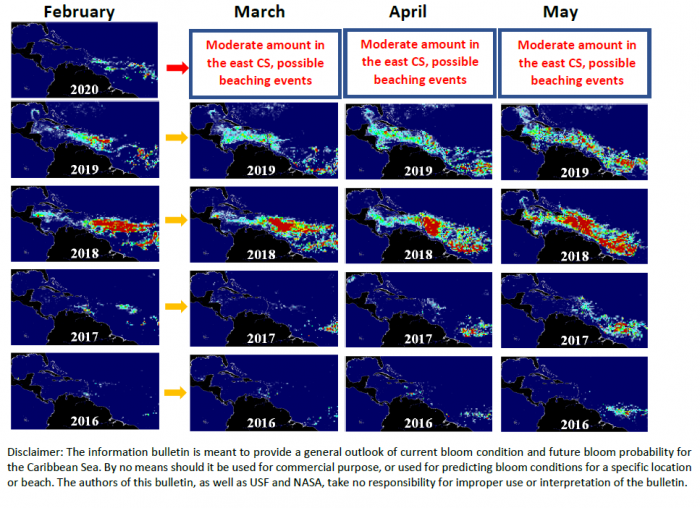The maps below show Sargassum abundance, with warm colors representing high abundance. In February 2020, the Sargassum amount continued to increase across the central Atlantic. Although the bloom magnitude is still lower than in some previous bloom years (2015, 2018, 2019), it is higher than in other years, and considerable amount of Sargassum is observed in the Central West Atlantic (CWA, i.e., the region east of the Lesser Antilles in the maps below) and the Central East Atlantic (CEA). In other regions Sargassum remains to be minimal, these include the Gulf of Mexico (GOM), Florida Straits, and Caribbean Sea (CS). In all regions combined, the total Sargassum amount increased from 1.0 million metric tons in January to 1.6 million tons in February, similar to February 2017 (1.6M tons). As predicted in January, some of the Lesser Antilles Islands (e.g., Barbados, Guadeloupe) appear to have experienced some small to moderate beaching events in February 2020.

Looking ahead, the CS will likely experience moderate amount of Sargassum in March to May 2020. Some of the Lesser Antilles Islands may continue experiencing small to moderate beaching events on their windward beaches. This situation may continue into summer, and the overall bloom intensity is likely to be similar as in 2017, based on the current observations. We will keep a close eye on how Sargassum in the tropical Atlantic may evolve in the next two months. More updates will be provided by the end of March 2020, and more information and near real-‐time imagery can be found under the Sargassum Watch System
(SaWS, https://optics.marine.usf.edu/projects/saws.html )



